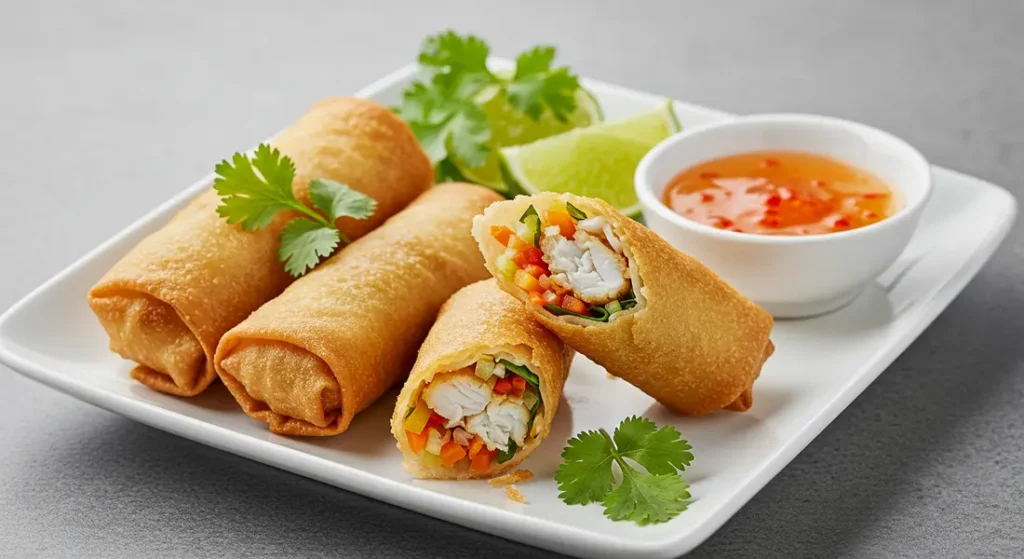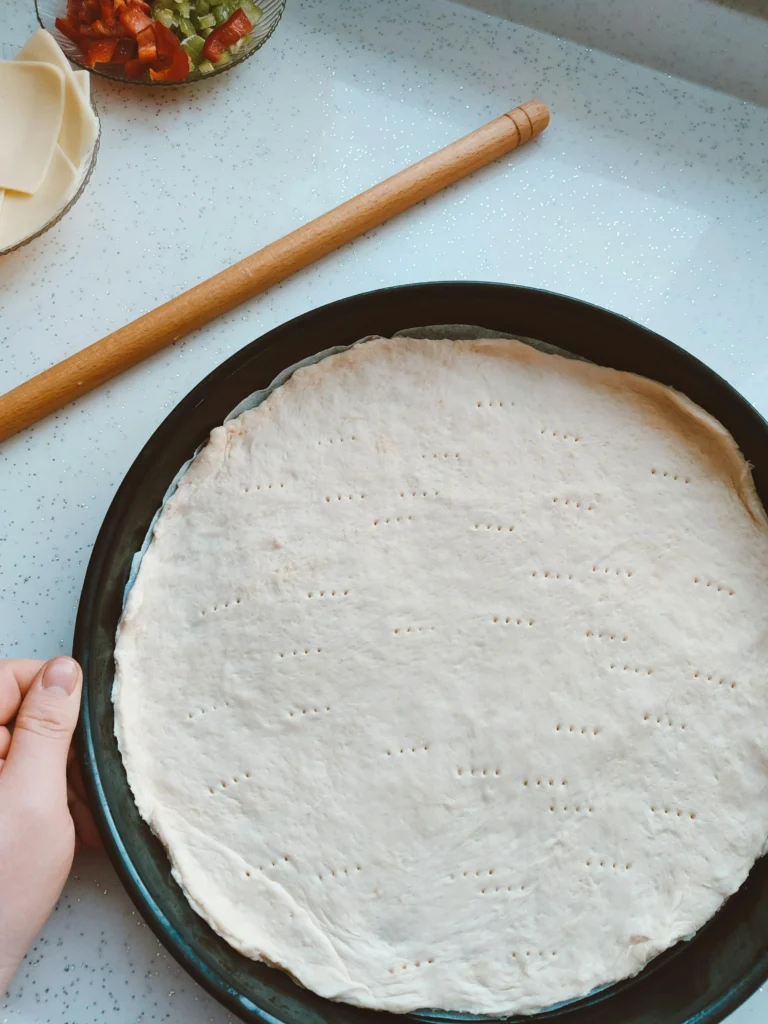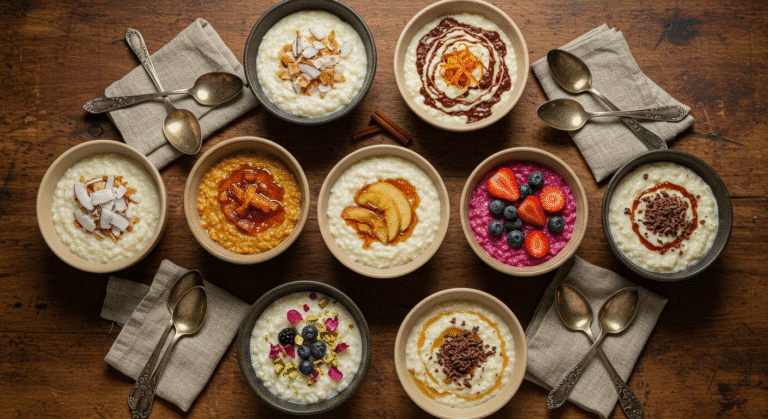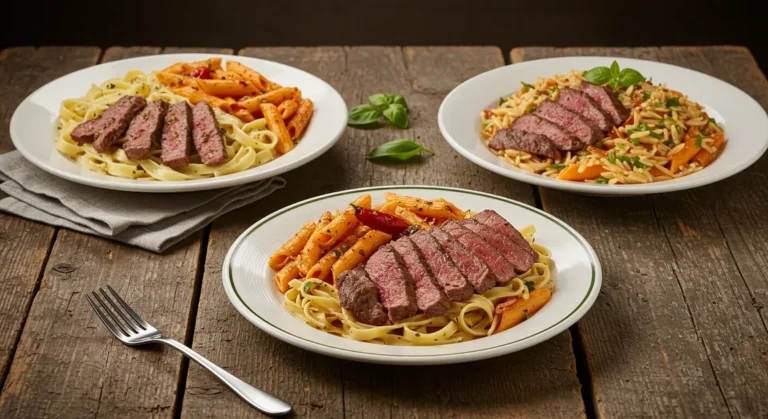Fresh and Crispy Fish Spring Rolls: The Ultimate Homemade Recipe
Learn how to make restaurant-quality fish spring rolls at home with this detailed guide. Perfect for appetizers, parties, or a light dinner option that’s sure to impress your family and friends.

Table of Contents
Introduction
Fish spring rolls are a delightful culinary creation that bring together the fresh flavors of seafood, crisp vegetables, and aromatic herbs, all wrapped in a light, crispy shell. This versatile dish, popular throughout Southeast Asia but with variations worldwide, offers a perfect balance of textures and tastes that make it an ideal appetizer, party food, or light meal option.
In this comprehensive guide, I’ll walk you through creating the perfect fish spring rolls from scratch, sharing professional tips and techniques that ensure crispy, flavorful results every time. Whether you’re new to Asian cuisine or looking to perfect your spring roll technique, this recipe will help you create restaurant-quality fish spring rolls in your own kitchen.

Why Fish Spring Rolls?
Fish spring rolls offer a lighter alternative to meat-based versions, making them perfect for seafood lovers and those seeking healthier options. The delicate flavor of fish pairs beautifully with fresh herbs and vegetables, creating a balanced and satisfying bite that’s both nutritious and delicious.
What sets this recipe apart is the careful selection of complementary ingredients that enhance the fish without overwhelming it, and a foolproof rolling technique that ensures your spring rolls stay intact during frying.
Ingredients
For the Spring Rolls:
- 1 pound (450g) firm white fish fillets (cod, tilapia, or snapper work well)
- 20 spring roll wrappers (rice paper or wheat-based)
- 2 cups bean sprouts
- 1 carrot, julienned
- 1 cucumber, seeds removed and julienned
- 1 red bell pepper, thinly sliced
- 4 green onions, thinly sliced
- 1/2 cup fresh cilantro leaves
- 1/4 cup fresh mint leaves
- 1/4 cup fresh basil leaves
- 3 cloves garlic, minced
- 1 tablespoon fresh ginger, grated
- 2 tablespoons soy sauce (low-sodium)
- 1 tablespoon fish sauce
- 1 teaspoon sesame oil
- 1 teaspoon honey or maple syrup
- 1 lime, juiced
- Vegetable oil for frying
For the Dipping Sauce:
- 1/4 cup sweet chili sauce
- 2 tablespoons soy sauce
- 1 tablespoon lime juice
- 1 teaspoon honey or maple syrup
- 1 small garlic clove, minced
- 1 teaspoon grated ginger
- 1 tablespoon finely chopped cilantro
- 1 teaspoon sesame seeds
Equipment Needed:
- Large skillet or wok
- Mixing bowls (various sizes)
- Cutting board and a sharp knife
- Vegetable peeler
- Grater for ginger and garlic
- Shallow dish for wrapper soaking
- Paper towels
- Tongs
- Wire cooling rack
- Food thermometer (optional but helpful)
- Serving platter
Step-by-Step Instructions
Preparing the Fish
- Season the fish: Pat the fish fillets dry with paper towels. In a small bowl, mix together minced garlic, grated ginger, soy sauce, fish sauce, sesame oil, honey, and lime juice. Pour this marinade over the fish and let it sit for 15-20 minutes.
- Cook the fish: Heat a skillet over medium heat. Add a small amount of oil and cook the marinated fish for about 3-4 minutes per side, or until it flakes easily with a fork. Remove from heat and let cool slightly.
- Flake the fish: Using two forks, gently flake the cooked fish into small pieces, removing any bones you might find. Set aside.
Preparing the Vegetables
- Wash and dry: Thoroughly wash all vegetables and herbs, then pat dry.
- Julienne the vegetables: Cut carrots, cucumber, and bell pepper into thin, matchstick-sized pieces (julienne). This uniform cutting style ensures even cooking and makes rolling easier.
- Prepare herbs: Roughly chop cilantro, mint, and basil, keeping some whole leaves for visual appeal.
- Combine: In a large bowl, toss together the vegetables and herbs. This can be done ahead of time and refrigerated until needed.
Making the Dipping Sauce
- Combine all dipping sauce ingredients in a small bowl.
- Stir well until the honey or maple syrup is completely dissolved.
- Let the sauce sit for at least 15 minutes to allow flavors to meld. This can be made up to 24 hours in advance and stored in the refrigerator.
Rolling the Spring Rolls
- Set up your rolling station: Arrange your flaked fish, vegetable mixture, and spring roll wrappers within easy reach. Have a clean, damp kitchen towel handy to cover rolled spring rolls to prevent drying out.
- Prepare the wrapper: If using rice paper wrappers, dip each wrapper in warm water for 5-10 seconds until just softened but still slightly firm (it will continue to soften). If using wheat-based wrappers, follow package instructions.
- Add fillings: Place the wrapper on a clean, flat surface. In the lower third of the wrapper, place a small amount of flaked fish (about 2 tablespoons) and top with about 3 tablespoons of the vegetable mixture.
- Roll: Fold the bottom edge over the filling, then fold in the sides. Continue rolling tightly until completely closed, similar to wrapping a burrito. The wrapper should be tight enough to hold the filling but not so tight that it tears.
- Repeat: Continue with the remaining wrappers and filling. Cover completed rolls with the damp towel as you work.

Cooking the Spring Rolls
- Heat the oil: In a large wok or deep skillet, heat about 2 inches of vegetable oil to 350°F (175°C). If you don’t have a thermometer, test the oil by dropping in a small piece of spring roll wrapper—it should sizzle immediately.
- Fry in batches: Carefully add spring rolls in batches (don’t overcrowd) and fry for 2-3 minutes or until golden brown and crispy, turning occasionally for even cooking.
- Drain: Remove with tongs and place on a wire rack lined with paper towels to drain excess oil.
- Keep warm: If making a large batch, keep cooked spring rolls warm in a 200°F (95°C) oven until all are cooked.

Serving Suggestions
Serve your fish spring rolls immediately while they’re still hot and crispy. Arrange them on a platter with the dipping sauce on the side. For an extra touch of freshness, garnish with:
- Additional fresh herbs (cilantro, mint, basil)
- Lime wedges
- Thinly sliced red chili (for those who enjoy heat)
- Extra bean sprouts
Fish spring rolls pair wonderfully with:
- A light Asian-inspired slaw
- Cucumber salad
- Jasmine or coconut rice
- A fresh fruit platter for dessert
Tips for Perfect Fish Spring Rolls
- Don’t overfill: It’s tempting to pack in the filling, but less is more for achieving a tight roll that won’t burst during frying.
- Roll tightly: Any air pockets will expand during frying, potentially causing the wrapper to burst.
- Maintain oil temperature: If the oil is too cool, the rolls will absorb excess oil and become greasy. If too hot, they’ll brown too quickly without cooking through.
- Fresh oil matters: Using fresh oil ensures clean flavor and better browning.
- Prepare ahead: The filling components can be prepared up to a day in advance, but assembly should happen just before cooking for the best texture.
- Alternative cooking method: If you prefer a healthier option, these spring rolls can be baked at 425°F (220°C) for about 15-20 minutes, turning halfway through. Brush lightly with oil before baking for a crisper result.

Variations to Try
- Salmon Spring Rolls: Substitute the white fish with salmon for a richer flavor profile.
- Spicy Fish Spring Rolls: Add thinly sliced jalapeños or a teaspoon of chili paste to the filling.
- Herb-Forward Version: Double the herbs for a fresher, more aromatic spring roll.
- Gluten-Free Option: Use rice paper wrappers and tamari instead of soy sauce.
Storage and Reheating
While fish spring rolls are best enjoyed fresh, you can:
- Store uncooked rolls: Separate with parchment paper and refrigerate for up to 24 hours.
- Store cooked rolls: Refrigerate in an airtight container for up to 2 days.
- Reheat: In a 350°F (175°C) oven for 10 minutes to restore crispness. Avoid microwaving as it will make them soggy.
Health Benefits
Fish spring rolls offer several nutritional benefits:
- Lean protein: The fish provides high-quality protein without excessive calories.
- Vegetable variety: The assortment of vegetables delivers essential vitamins, minerals, and fiber.
- Healthy fats: If using fatty fish like salmon, you’ll get beneficial omega-3 fatty acids.
- Balanced meal: When paired with a dipping sauce and side salad, fish spring rolls make a well-rounded meal option.
Frequently Asked Questions
Can I make fish spring rolls in advance?
You can prepare the components (cooked fish, cut vegetables, sauce) up to 24 hours in advance, but it’s best to assemble and cook the spring rolls just before serving for optimal crispness and texture.
What type of fish works best for spring rolls?
Firm white fish like cod, tilapia, haddock, or snapper work best as they hold their shape well after cooking. Salmon is also excellent for a richer flavor profile.
Can I bake these instead of frying?
Yes! For a healthier option, brush the rolls lightly with oil and bake at 425°F (220°C) for 15-20 minutes, turning halfway through, until golden and crispy.
How do I prevent my spring rolls from becoming soggy?
Ensure all filling ingredients are as dry as possible before rolling. If using rice paper wrappers, don’t oversoak them. Also, make sure your oil is hot enough for frying (350°F/175°C).
What can I substitute for fish sauce?
You can use soy sauce with a squeeze of lime juice, though the flavor won’t be exactly the same. Vegetarian “fish sauce” alternatives are also available in many Asian grocery stores.
Can I freeze fish spring rolls?
Yes, you can freeze uncooked spring rolls separated by parchment paper in an airtight container for up to 1 month. Cook directly from frozen, adding 1-2 minutes to the cooking time.
What if my spring rolls are falling apart?
This usually happens if the wrapper is too wet or if there’s too much filling. Try using less filling and ensure your wrapper is just damp enough to be pliable, not soaking wet.
Conclusion
Mastering the art of fish spring rolls opens up a world of culinary possibilities. These crispy, flavorful bundles make impressive appetizers for guests or a satisfying meal for your family. The combination of flaky fish, crunchy vegetables, and aromatic herbs creates a perfect balance of flavors and textures that’s hard to resist.
With this detailed guide, you now have all the knowledge needed to create restaurant-quality fish spring rolls at home. Remember that practice makes perfect, so don’t be discouraged if your first few rolls aren’t picture-perfect. The technique becomes easier with each attempt, and even imperfectly shaped spring rolls will taste delicious!
So gather your ingredients, set up your rolling station, and prepare to delight in the crispy, fresh flavors of homemade fish spring rolls. Your taste buds, and impressed dinner guests will thank you!
For more recipes, visit us!!!







